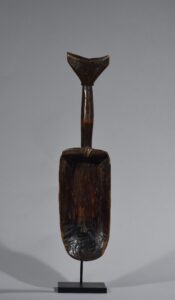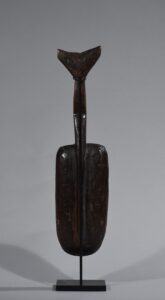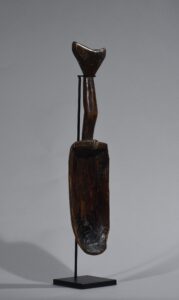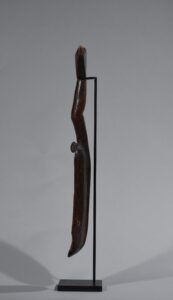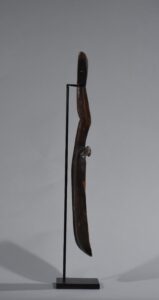MCK 1099-2A
Beautiful Antique, Primitive West African Wooden Spoon (Guro), Ivory Coast
This beautiful, ancient, primitive wooden spoon is considered to have originated from West Africa and most probably from the Guro tribe. It has all the signs of age and diligent use. The simple and sculptural handle could very well have been designed by a modern sculptor. You sense a slight elegance in the wood’s beautiful dark brown patina and the small, neat and symbolic ‘knot’ at the transition from the handle to the ‘shovel’ itself enhances the aesthetics of the shape. The clever ‘head’ of the handle leads to the thought of the buffalo’s horn, as does the ‘handle’ itself, which suggests the woman’s concave torso.
Guro, also spelled Gouro, also called Kweni, people of Côte d’Ivoire (Ivory Coast), in the valley regions of the Bandama River; they speak a language from the Mande branch of the Niger-Congo family of African languages. The Guro originally came from the north and northwest, driven by Mande invasions in the second half of the 18th century.
Guro villages consist of several patrilineages, the basic social and economic units of the Guro community. They are headed by their oldest members, who form a village council. In the traditional Guro community, there was no office for village chief, but a prominent kinship was recognized as prominent; he was heard in the settlement of disputes and represented the village to outsiders.
Guro preserve their own religion, involving many cults and deities. A landowner sacrifices to the land for the benefit of the village and its inhabitants. Each village also has a diviner who is consulted before important decisions are made. (quote from Brit Guro, also spelled Gouro, also called Kweni, people from Côte d’Ivoire (Ivory Coast), in the valley regions of the Bandama River; they speak a language in the Mande branch of the Niger-Congo family of African languages Guro came originally from the north and northwest driven by Mande invasions in the second half of the 18th century.
Guro preserve their own religion, involving many cults and deities. A landowner sacrifices to the land for the benefit of the village and its inhabitants. Each village also has a diviner who is consulted before important decisions are made. (Quote from Britannica Encyclopedia).
Age: Est. beg. 20th century.
Measure: H: 34 (39), W: 8½, D: 3½ cm.
Provenance: Danish painter who bought it at an ‘African market’ in Paris in the 1950s.
Literatur: “Guro: Masks, Performances, and Master Carvers in Ivory Coast”, April 30, 2008
Request price for Guro Spoon
